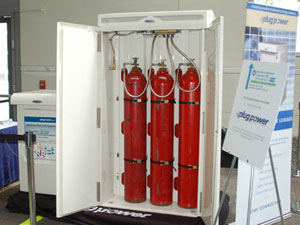Arno's EnergyIdeas (35)
U.S. Department of Energy reduces hydrogen and fuel cells funding for 2010 drastically - still warm rain in 2009, though
Great was the excitement in the international hydrogen and fuel cell community, as the U.S. Department of Energy (DOE) published its budget estimates for fiscal year (FY) 2010 in early May 2009. The plans foresee dramatic reductions in hydrogen and fuel cell programs. The National Hydrogen Association (NHA) and the U.S. Fuel Cell Council (USFCC), both from Washington, DC, released their criticism of this budget planning in a joint statement immediately. These two organizations represent more than 200 mostly US American hydrogen and fuel cell companies and organizations.

The Hydrogen Storage Module HSM (foreground) by Plug Power Inc. supplies the Electrical Energy Storage Module (EESM), Type Gencor ® 5T48 with hydrogen. There are 5kW electrical power (backup power) generated at 24 or 48 V DC
Photo: Arno A. Evers FAIR-PR, seen in Sacramento, CA, USA |
For the DOE Fuel Cell Technology program, formerly known as "hydrogen, fuel cells and infrastructure technologies“, the current FY 2009 budget of U.S. $ 168,960,000, should shrink in 2010 to U.S. $ 68,213,000. In 2010, U.S. $ 65,213,000 of these funds are entitled for "Fuel Cell Systems R & D", this topic was not even considered in the FY 2008 and 2009. Additional U.S. $ 5,000,000 are intended for "System analysis", for this U.S. $ 7,713,000 was planned in 2009.
Zeroed out completely are “Hydrogen Production and Delivery R&D”, “Hydrogen Storage R&D”, “Fuel Cell Stack Component R&D”, “Technology Validation”, “Transportation Fuel Cell Systems;” “Distributed Energy Fuel Cell Systems”, “Fuel Processor R&D”, “Safety Codes & Standards” (also supposed to restart in FY 2010), “Education”, “Market Transformation” and “Manufacturing R&D.”
Whew, as the Indians say, there is in fact not much left. Accordingly, immense was the criticism of the two above-mentioned U.S. associations, who, at the first time since their foundation gave out a joint press release. Quotes from this statement:
"(...) the cuts proposed in the DOE hydrogen and fuel cell program threaten to disrupt commercialization of a family of technologies that are showing exceptional promise and beginning to gain market traction. Fuel cell vehicles are not a science experiment. These are real vehicles with real marketability and real benefits. Hundreds of fuel cell vehicles have collectively logged millions of miles (...) “
Perhaps these "complaints" of the two U.S. organizations are coming a little late, perhaps they and their member companies and organizations should have acted years ago and should have done more to advance towards market-orientation with hydrogen and fuel cells. Focusing on the "technical feasibility" alone - in the implementation of new technologies – was maybe too little. When in 1995, we started to implement the Group Exhibition Hydrogen and Fuel Cells at the Hannover Fair in Germany, we have always been working according to the slogan: "Go to where the market is!" Our first criterion was and still is, to create added value for our customers. This mindset is missing, to my understanding, in hydrogen and fuel cells - and this not in the U.S. only.
What will happen next? There are not too many alternatives, though. The above proposals will overcome the U.S. administrative hurdles, and - conceivably with some small modifications – then be adopted. The decisive question now goes to the companies: Are you going to carry on alone or will you wait until the DOE budget situation will improve in the coming years? This would mean we are all loosing time. Time, which we do not even have in the end! The U.S. research institutions will certainly find opportunities to continue with their H2/FC (basic) research. And what will the consumer do? He will wonder again, that only slightly visible, and rather little tangible products and services will be on the market - with "Hydrogen and Fuel Cells - inside.
What this entire issue means for Germany, we are going to see!
However, the reports from the U.S. are somewhat confusingly, since a few days before this "terrible message" the same DOE announced that U.S. $ 41,900,000, will be funded “(...) to support the immediate deployment of nearly 1,000 fuel cell systems for emergency backup power and material handling applications (forklifts) that have emerged as key early markets in which fuel cells can compete with conventional power technologies. Quoting DOE, the recipients, awards and projects are:
FedEx Freight East - $1.3 million to deploy 35 fuel cell forklifts in Springfield, Missouri.
Jadoo Power, Acumentrics Corporation, NASCAR Media Group, Lynch Diversified Vehicles, California's Police and Fire Departments of the City of Folsom, and Airgas, Inc. - $1.8 million to establish the environmental and cost benefits of using a 1-kW fuel cell power system to generate electricity.
PolyFuel, Inc. - $2.5 million to further integrate and miniaturize the components of PolyFuel’s portable power system for use in mobile computing, and analyze failure modes to increase durability.
Anheuser-Busch - $1.1 million to deploy 23 fuel cell forklifts at their facility in Fort Collins, Colorado.
Nuvera Fuel Cells - $1.1 million to deploy 10 fuel cell forklifts at East Penn Manufacturing’s facility in Topton, Pennsylvania.
Delphi Automotive - $2.4 million to develop, test and demonstrate a 3- to 5-kW solid oxide fuel cell (SOFC) auxiliary power unit (APU) for heavy duty commercial class 8 trucks.
MTI MicroFuel Cells - $2.4 million to accelerate fuel cell use in consumer markets by demonstrating a one-watt consumer electronics power pack.
Plug Power, Inc. – $3.4 million to validate the durability of Plug Power’s 5-kW stationary combined heat and power fuel cell system and $2.7 million to demonstrate the market viability of the GenCore® rack-mounted fuel cell product (275 kW of backup power).
GENCO - $6.1 million (six awards) to deploy 156 fuel cell systems as battery replacements for fleets of electric lift trucks at six of GENCO’s existing distribution centers (South Carolina, Pennsylvania - 3 locations, and Ohio - 2 locations).
Sysco - $1.2 million to deploy 90 fuel cell forklifts at Sysco’s new distribution center in Houston, Texas, due to open in August 2009.
Sprint Communications - $7.3 million to demonstrate the viability of packaged 1-kW to 10-kW fuel cell systems with 72 hours of on-site fuel storage for backup power to communication infrastructure used by state and local first responders and by public safety answering points (911 centers).
ReliOn Inc. - $8.6 million (two awards) to deploy 180 fuel cells with a new refillable 72-hour fuel system to locations across the AT&T Mobility Network, providing back up power to 25 sites throughout central and northern California.
I am rather confused about this list as there are four things striking me: Firstly, with the publication of the funding, the recipients of the grants were already announced. Secondly, manufacturers
(suppliers) and users (customers) are mixed up in a very strangely way. Thirdly, the above mentioned companies are in fact not poverty-stricken, be there a crisis or not. Fourthly, the origin of the hydrogen as an energy carrier, once again, was absolutely not put into question.
Photo caption: The Hydrogen Storage Module HSM (foreground) by Plug Power Inc. supplies the Electrical Energy Storage Module (EESM), Type Gencor ® 5T48 with hydrogen. There are 5kW electrical power (backup power) generated at 24 or 48 V DC
Photo: Arno A. Evers FAIR-PR, seen in Sacramento, CA, USA
Links to the news:
Date: 12.05.2009 |
